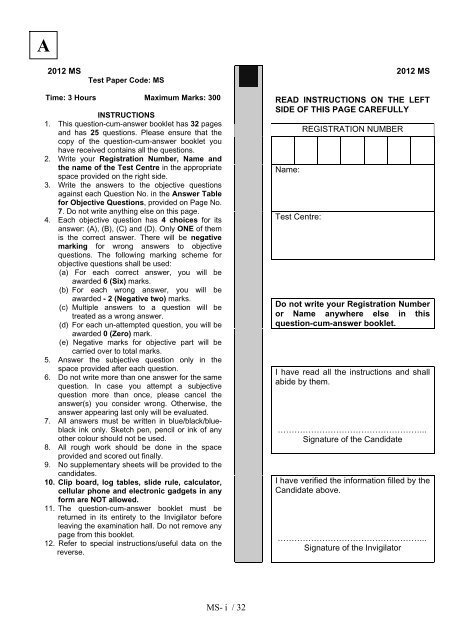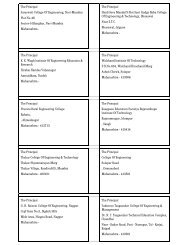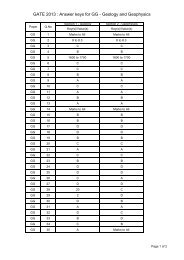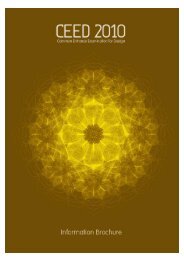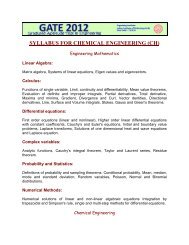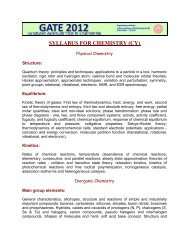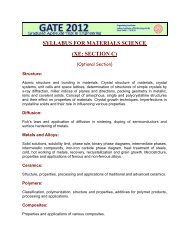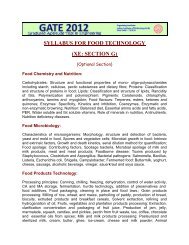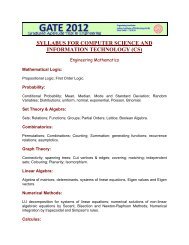Mathematical Statistics - GATE
Mathematical Statistics - GATE
Mathematical Statistics - GATE
Create successful ePaper yourself
Turn your PDF publications into a flip-book with our unique Google optimized e-Paper software.
A<br />
2012 MS<br />
Test Paper Code: MS<br />
2012 MS<br />
Time: 3 Hours Maximum Marks: 300<br />
INSTRUCTIONS<br />
1. This question-cum-answer booklet has 32 pages<br />
and has 25 questions. Please ensure that the<br />
copy of the question-cum-answer booklet you<br />
have received contains all the questions.<br />
2. Write your Registration Number, Name and<br />
the name of the Test Centre in the appropriate<br />
space provided on the right side.<br />
3. Write the answers to the objective questions<br />
against each Question No. in the Answer Table<br />
for Objective Questions, provided on Page No.<br />
7. Do not write anything else on this page.<br />
4. Each objective question has 4 choices for its<br />
answer: (A), (B), (C) and (D). Only ONE of them<br />
is the correct answer. There will be negative<br />
marking for wrong answers to objective<br />
questions. The following marking scheme for<br />
objective questions shall be used:<br />
(a) For each correct answer, you will be<br />
awarded 6 (Six) marks.<br />
(b) For each wrong answer, you will be<br />
awarded - 2 (Negative two) marks.<br />
(c) Multiple answers to a question will be<br />
treated as a wrong answer.<br />
(d) For each un-attempted question, you will be<br />
awarded 0 (Zero) mark.<br />
(e) Negative marks for objective part will be<br />
carried over to total marks.<br />
5. Answer the subjective question only in the<br />
space provided after each question.<br />
6. Do not write more than one answer for the same<br />
question. In case you attempt a subjective<br />
question more than once, please cancel the<br />
answer(s) you consider wrong. Otherwise, the<br />
answer appearing last only will be evaluated.<br />
7. All answers must be written in blue/black/blueblack<br />
ink only. Sketch pen, pencil or ink of any<br />
other colour should not be used.<br />
8. All rough work should be done in the space<br />
provided and scored out finally.<br />
9. No supplementary sheets will be provided to the<br />
candidates.<br />
10. Clip board, log tables, slide rule, calculator,<br />
cellular phone and electronic gadgets in any<br />
form are NOT allowed.<br />
11. The question-cum-answer booklet must be<br />
returned in its entirety to the Invigilator before<br />
leaving the examination hall. Do not remove any<br />
page from this booklet.<br />
12. Refer to special instructions/useful data on the<br />
reverse.<br />
READ INSTRUCTIONS ON THE LEFT<br />
SIDE OF THIS PAGE CAREFULLY<br />
Name:<br />
Test Centre:<br />
REGISTRATION NUMBER<br />
Do not write your Registration Number<br />
or Name anywhere else in this<br />
question-cum-answer booklet.<br />
I have read all the instructions and shall<br />
abide by them.<br />
……………………………………………...<br />
Signature of the Candidate<br />
I have verified the information filled by the<br />
Candidate above.<br />
……………………………………………...<br />
Signature of the Invigilator<br />
MS- i / 32
Special Instructions/ Useful Data<br />
1. : Set of all real numbers.<br />
2. i.i.d. : independent and identically distributed.<br />
2<br />
3. N( , ) : Normal distribution with mean and variance<br />
2<br />
0 .<br />
4. For a fixed 0 , X ~ Exp(<br />
) means that the probability<br />
density function of random variable X is<br />
x<br />
e<br />
if x0,<br />
f( x; )<br />
<br />
0 otherwise.<br />
5. Uab: ( , ) Uniform distribution on ( a, b ) , a b<br />
.<br />
6. B( np: , ) Binomial distribution with parameters n {1,2,...} and<br />
p (0,1).<br />
7. EX ( ): Expectation of X.<br />
8. F<br />
mn ,<br />
: F distribution with m and n degrees of freedom.<br />
1<br />
n<br />
9. x xi<br />
n<br />
is the sample mean based on ( x ,..., x 1 n)<br />
.<br />
i 1<br />
10. = P [type I error] and = P [type II error]<br />
11. H<br />
0<br />
: Null Hypothesis, H<br />
1<br />
: Alternative Hypothesis<br />
Useful data<br />
z<br />
2<br />
x<br />
<br />
2<br />
1<br />
( z)<br />
e dx , where ( z)<br />
is cumulative distribution<br />
2<br />
<br />
function of N(0, 1) .<br />
(1.28) 0.900 , (1.65) 0.950 , (1.96) 0.975 ,<br />
(2.33) 0.990 , (2.58) 0.995<br />
.<br />
MS- ii / 32
IMPORTANT NOTE FOR CANDIDATES<br />
Questions 1-15 (objective questions) carry six marks each and questions 16-25 (subjective<br />
questions) carry twenty one marks each.<br />
Write the answers to the objective questions in the Answer Table for Objective Questions<br />
provided on page 7 only.<br />
Q.1<br />
An eigenvector of the matrix<br />
M<br />
2 1 0<br />
<br />
0 2 1<br />
0 0 2<br />
<br />
is<br />
(A)<br />
1<br />
<br />
0<br />
0<br />
<br />
(B)<br />
0<br />
<br />
1<br />
0<br />
<br />
(C)<br />
0<br />
<br />
0<br />
1<br />
<br />
(D)<br />
2<br />
<br />
2<br />
2<br />
<br />
Q.2<br />
The volume of the solid of revolution generated by revolving the area bounded by the curve<br />
y x and the straight lines x4 and y 0 about the x<br />
axis, is<br />
(A) 2π (B) 4π (C) 8π (D) 12π<br />
Q.3<br />
Let<br />
1 2x<br />
I xy dy dx.<br />
The change of order of integration in the integral gives I as<br />
<br />
0<br />
2<br />
x<br />
(A)<br />
(B)<br />
(C)<br />
(D)<br />
1 y<br />
2<br />
2<br />
y<br />
<br />
I xy dx dy xy dx dy.<br />
0 0 1 0<br />
1 2y<br />
2 2y<br />
<br />
I xy dx dy xy dx dy.<br />
0 0 1 0<br />
1 y<br />
1<br />
2<br />
y<br />
<br />
I xy dx dy xy dx dy.<br />
0 0 0 0<br />
1 2<br />
y<br />
2<br />
<br />
I xy dx dy xy dx dy.<br />
0 0 1 0<br />
y<br />
Q.4<br />
1 2 k<br />
<br />
Let L lim n f f f k f(0)<br />
n<br />
<br />
<br />
n n n<br />
, where k is a positive integer. If<br />
<br />
f( x) sin x, then L is equal to<br />
(A) ( k 1)( k 2 )<br />
6<br />
(B)<br />
( k1)( k2)<br />
2<br />
(C)<br />
kk ( 1)<br />
2<br />
(D) kk ( 1)<br />
MS- 1 / 32
Q.5<br />
<br />
2 2 1 <br />
x y sin if ( x, y) (0,0)<br />
Let f( x, y)<br />
2 2<br />
x y <br />
<br />
<br />
0 if ( xy , ) (0,0).<br />
Then at the point ( 0,0),<br />
f<br />
f<br />
(A) f is continuous and and<br />
x<br />
y<br />
exist.<br />
f<br />
f<br />
(B) f is continuous and and<br />
x<br />
y<br />
do not exist.<br />
f<br />
f<br />
(C) f is not continuous and and<br />
x<br />
y<br />
exist.<br />
f<br />
f<br />
(D) f is not continuous and and<br />
x<br />
y<br />
do not exist.<br />
Q.6 Let be a real sequence converging to a, where a 0. Then<br />
a n<br />
<br />
a n<br />
1<br />
<br />
a n<br />
1<br />
(A) converges but diverges.<br />
1 n<br />
<br />
a<br />
(B) diverges but <br />
n<br />
converges.<br />
1 n<br />
<br />
<br />
a<br />
(C) Both a n<br />
and <br />
n<br />
converge.<br />
1<br />
1 n<br />
<br />
<br />
a<br />
(D) Both a n<br />
and <br />
n<br />
diverge.<br />
n<br />
1<br />
1<br />
<br />
a n<br />
Q.7 A four digit number is chosen at random. The probability that there are exactly two zeros in<br />
that number is<br />
(A) 0.73 (B) 0.973 (C) 0.027 (D) 0.27<br />
Q.8 A person makes repeated attempts to destroy a target. Attempts are made independent of each<br />
other. The probability of destroying the target in any attempt is 0.8. Given that he fails to<br />
destroy the target in the first five attempts, the probability that the target is destroyed in the 8 th<br />
attempt is<br />
(A) 0.128 (B) 0.032 (C) 0.160 (D) 0.064<br />
Q.9<br />
Let the random variable X B(5, p)<br />
such that PX ( 2) 2 PX ( 3)<br />
. Then the variance of X is<br />
(A) 10 3<br />
(B) 10 9<br />
(C) 5 3<br />
(D) 5 9<br />
MS- 2 / 32
Q.10<br />
Let X , , X be i.i.d. 2<br />
1 8<br />
N(0, ) random variables. Further, let U X1 X 2<br />
and<br />
The correlation coefficient between U and V is<br />
V<br />
8<br />
Xi<br />
.<br />
i1<br />
(A)<br />
1<br />
8<br />
(B)<br />
1<br />
4<br />
(C)<br />
3<br />
4<br />
(D) 1 2<br />
Q.11 Let X ~ F<br />
8,15<br />
and Y ~ F<br />
15,8<br />
. If PX ( 4) 0.01 and PY ( k ) 0.01, then the value of k is<br />
(A) 0.025 (B) 0.25 (C) 2 (D) 4<br />
Q.12<br />
Let X , , 1<br />
X<br />
n<br />
be i.i.d. Exp(1) random variables and<br />
theorem, the value of<br />
lim PS<br />
n<br />
( n<br />
n) is<br />
S<br />
n<br />
<br />
n<br />
<br />
i1<br />
Xi<br />
. Using the central limit<br />
(A) 0<br />
(B) 1 3<br />
(C)<br />
1<br />
2<br />
(D) 1<br />
Q.13 Let the random variable X U(5,5 <br />
) . Based on a random sample of size 1, say X<br />
1<br />
, the<br />
2<br />
unbiased estimator of is<br />
(A)<br />
3( X 5)<br />
1<br />
2<br />
(B)<br />
X <br />
12<br />
2<br />
1<br />
5<br />
(C)<br />
3( X 5)<br />
1<br />
2<br />
(D)<br />
X <br />
12<br />
2<br />
1<br />
5<br />
Q.14<br />
Let X , , 1<br />
X<br />
n<br />
be a random sample of size n from N( ,16) population. If a 95% confidence<br />
interval for is X<br />
0.98, X 0.98 , then the value of n is<br />
(A) 4<br />
(B) 16 (C) 32 (D) 64<br />
Q.15<br />
A coin is tossed 4 times and p is the probability of getting head in a single trial. Let S be the<br />
number of head(s) obtained. It is decided to test<br />
H : 1<br />
0<br />
p against<br />
1<br />
2<br />
H : 1<br />
p , using the decision rule : Reject H 0<br />
if S is 0 or 4. The<br />
2<br />
probabilities of Type I error ( ), and Type II error ( ) when p = 3 4 , are<br />
1 8<br />
(A) , 7<br />
4 128<br />
1 8<br />
(B) , 7<br />
8 128<br />
1 41<br />
(C) <br />
, <br />
8 256<br />
1 41<br />
(D) <br />
, <br />
4 256<br />
MS- 3 / 32
Space for rough work<br />
MS- 4 / 32
Space for rough work<br />
MS- 5 / 32
Space for rough work<br />
MS- 6 / 32
Answer Table for Objective Questions<br />
Write the Code of your chosen answer only in the ‘Answer’ column against each<br />
Question Number. Do not write anything else on this page.<br />
Question<br />
Number<br />
01<br />
02<br />
03<br />
04<br />
05<br />
06<br />
07<br />
08<br />
09<br />
10<br />
11<br />
12<br />
13<br />
14<br />
15<br />
Answer<br />
Do not write<br />
in this column<br />
FOR EVALUATION ONLY<br />
Number of Correct Answers Marks ( + )<br />
Number of Incorrect Answers Marks ( )<br />
Total Marks in Questions 1-15 ( )<br />
MS- 7 / 32
Q.16 (a) Find the value(s) of for which the following system of linear equations<br />
<br />
1 1 x<br />
1<br />
<br />
1 1<br />
y<br />
<br />
1<br />
1 1 z<br />
<br />
1<br />
(i) has a unique solution,<br />
(ii) has infinitely many solutions,<br />
(iii) has no solution. (9)<br />
(b)<br />
a b 2a b<br />
Let a 2, b 1 and for n1, a , b . Show that<br />
n n n n<br />
1 1 n1 n1<br />
2 an<br />
bn<br />
(i) b a for all n,<br />
n<br />
(ii) b b for all n,<br />
(iii) the sequences<br />
n<br />
n1<br />
n<br />
n <br />
a and <br />
b n<br />
converge to the same limit 2 . (12)<br />
MS- 8 / 32
MS- 9 / 32
Q.17 (a) 2 3<br />
Solve: <br />
x y xy dy dx.<br />
(b) Find the general solution of the differential equation<br />
2<br />
d<br />
D 4D4y xsin2 x, where D<br />
. dx<br />
(9)<br />
(12)<br />
MS- 10 / 32
MS- 11 / 32
Q.18 (a)<br />
3 3<br />
Find all the critical points of the function f ( xy , ) xy 3xyand examine<br />
those points for local maxima and local minima. (9)<br />
(b) If f is a continuous real-valued function on [0,1] , show that there exists a<br />
point c ( 0,1) such that<br />
1 1<br />
x f( x) dx<br />
f( x)<br />
dx .<br />
0<br />
c<br />
(12)<br />
MS- 12 / 32
MS- 13 / 32
Q.19<br />
(a)<br />
Evaluate the triple integral:<br />
z4 x2<br />
z<br />
y<br />
2 4zx<br />
dy dx dz .<br />
z0 x0 y0<br />
(9)<br />
(b)<br />
1 2 0<br />
Let<br />
1 5 1<br />
M 0 2 1<br />
. If M I kM M<br />
2 , where I is the identity matrix<br />
1 0 1<br />
4 4<br />
<br />
of order 3, find the value of k. Hence or otherwise, solve the system of<br />
x<br />
1<br />
<br />
equations:<br />
M<br />
y<br />
<br />
0 .<br />
z<br />
<br />
0<br />
<br />
(12)<br />
MS- 14 / 32
MS- 15 / 32
Q.20 (a) Let N be a random variable representing the number of fair dice thrown with<br />
1<br />
probability mass function PN ( i)<br />
, i 1,2,<br />
. Let S be the sum of the<br />
2 i<br />
numbers appearing on the faces of the dice. Given that S = 3, what is the<br />
probability that 2 dice were thrown ? (9)<br />
(b)<br />
Let X N(0,1)<br />
and Y X X . Find EY ( ). (12)<br />
3<br />
MS- 16 / 32
MS- 17 / 32
Q.21<br />
2<br />
Let Y N( , ) and Y ln X .<br />
y<br />
y<br />
(a) Find the probability density function of the random variable X and the median of X. (9)<br />
(b) Find the maximum likelihood estimator of the median of the random variable X<br />
based on a random sample of size n. (12)<br />
MS- 18 / 32
MS- 19/<br />
32
Q.22 (a) A random variable X has probability density function<br />
<br />
2x2<br />
<br />
If EX ( ) , determine and .<br />
2<br />
<br />
f( x) <br />
xe , x0, 0, 0.<br />
(9)<br />
(b) Let X and Y be two random variables with joint probability density function<br />
y<br />
e<br />
if 0 x y,<br />
f( x, y)<br />
<br />
0 otherwise.<br />
(i) Find the marginal density functions of X and Y .<br />
(ii) Examine whether X and Y are independent.<br />
(iii) Find Cov( X , Y ) . (12)<br />
MS- 20/ 32
MS- 21 / 32
Q.23 (a)<br />
1<br />
<br />
Let X , 1<br />
, X<br />
n<br />
be a random sample from Exp population. Obtain the<br />
<br />
2<br />
Cramer – Rao lower bound for the variance of an unbiased estimator of . (9)<br />
(b) Let X , , 1<br />
X<br />
n<br />
(n > 4) be a random sample from a population with mean and<br />
2<br />
variance . Consider the following estimators of <br />
1 n Xi<br />
n i 1<br />
U , 1 3<br />
1<br />
V X 1 ( X 2 X 1 )<br />
8 4( n 2) n <br />
X .<br />
<br />
8 n<br />
(i) Examine whether the estimators U and V are unbiased.<br />
(ii) Examine whether the estimators U and V are consistent.<br />
(iii) Which of these two estimators is more efficient? Justify your answer. (12)<br />
MS- 22 / 32
MS- 23 / 32
Q.24 Let X , , 1<br />
X<br />
n<br />
be a random sample from a Bernoulli population with parameter p.<br />
(a) (i) Find a sufficient statistic for p.<br />
p(1 p)<br />
(ii) Consider an estimator U( X1, X2)<br />
of given by<br />
n<br />
1<br />
if X1<br />
X2<br />
1,<br />
U( X1, X2) 2n<br />
0 otherwise.<br />
Examine whether U( X , X ) is an unbiased estimator.<br />
1 2<br />
(9)<br />
(b)<br />
Using the results obtained in (a) above and Rao – Blackwell theorem, find the<br />
p(1 p)<br />
uniformly minimum variance unbiased estimator (UMVUE) of .<br />
n<br />
(12)<br />
MS- 24 / 32
MS- 25 / 32
Q.25 (a) Let X , , 1<br />
X<br />
n<br />
be a random sample from the population having probability density<br />
function<br />
2<br />
x<br />
2x <br />
2<br />
<br />
f( x, )<br />
if 0<br />
2 e<br />
<br />
x <br />
<br />
<br />
0 otherwise.<br />
Obtain the most powerful test for testing H0 : 0<br />
against H1:<br />
1<br />
( 1<br />
0<br />
). (9)<br />
(b) Let X , , 1<br />
X<br />
n<br />
be a random sample of size n from N( ,1) population. To test<br />
H<br />
0<br />
: 5 against H : 4<br />
1<br />
, the decision ru le is : Reject H<br />
0<br />
if x c . If<br />
0.05 and 0.10 , determine n (rounded off to an integer) and hence c. (12)<br />
MS- 26 / 32
MS- 27 / 32
Space for rough work<br />
MS- 28 / 32
Space for rough work<br />
MS- 29 / 32
Space for rough work<br />
MS- 30 / 32
Space for rough work<br />
MS- 31 / 32
Space for rough work<br />
MS- 32 / 32
2012 MS<br />
Objective Part<br />
( Question Number 1 – 15)<br />
Total Marks<br />
Signature<br />
Subjective Part<br />
Question<br />
Number<br />
Marks<br />
Question<br />
Number<br />
16 21<br />
17 22<br />
18 23<br />
19 24<br />
20 25<br />
Marks<br />
Total Marks in Subjective Part<br />
Total (Objective Part) :<br />
Total (Subjective Part) :<br />
Grand Total :<br />
Total Marks (in words) :<br />
Signature of Examiner(s) :<br />
Signature of Head Examiner(s) :<br />
Signature of Scrutinizer :<br />
Signature of Chief Scrutinizer :<br />
Signature of Coordinating<br />
Head Examiner<br />
:<br />
MS- iii / 32


